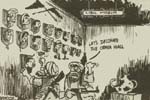Pakistan government buying stolen antiquesIslamabad, Aug. 6: In what was described by most experts as a surprise decision, the Cabinet approved last month a supplementary grant of Rs 30 million to procure antiques, metal and glassware, manuscripts and paintings available in the local market or in private hands. Following the Cabinet directive, the Finance Division agreed last week to provide the huge amount for procurement from local market of artifacts/ manuscripts/arts pieces of Afghanistan or Central Asian origin for display in National Museum in Islamabad. The only thing which happened recently was unconfirmed reports that a large number of high value pieces of carved ivory stolen from the Afghan National Museum in Kabul have been brought to Peshawar and were offered for sale to a very few, highly connected persons. It is understood that some of the Afghan ivory pieces have already been sold to individuals and smuggled out of Pakistan but more than one hundred pieces are still reported to be available with a man in Peshawar who according to one expert was operating under an assumed name. The Afghan treasure of carved ivory was discovered at village Begram, some 40 miles north-east of Kabul and dates back to 2nd century AD. They come from a period when the Kushan Empire covered a vast area from northern India up to the upper regions of Central Asia. Artifacts from this period, therefore, can be classified as of Central Asian Afghan origin. The decision of the Cabinet came as a surprise for people who are knowledgeable about the international law on sale/purchase of archeological pieces belonging to the cultural heritage of another nation. They advise that care must be taken while selecting items for purchase from the supplementary grant for display at Pakistan National Museum because if even one item stolen from Kabul museum is procured by the Government of Pakistan, it would amount to a clear violation of the 1972 UN convention of Protection of National Heritage of the member states. Pakistan is a signatory to the Convention. THE MUSLIM, August 7, 1995
|
UNESCO calls on dealers to respect Afghan art heritagePARIS (AFP) - UNESCO director general Federico Mayor called Wednesday on art dealers and collectors to refrain from acquiring objects that formed part of Afghanistan’s cultural heritage but were looted from Kabul’s central museum last November. The international art market has recently begun trading in articles from Afghanistan that have found their way to the west after a rocket attack on the museum enabled looters to make off with many valuable items. Officials of the UN Educational Scientific and Cultural Organization warned that "looters stripped the national museum in Kabul, the Jalalabad museum was destroyed and several art objects were sold in the west." The loss to the Asian country’s heritage was "massive", they said in a statement. Mayor called on dealers and collectors to "respect scrupulously the interests of the Afghan people by refraining from acquiring objects that might have been stolen from them." The Frontier Post, April 1,1994
|
Where is the selling market of the Kabul museum’s antiques?CIA, Peshawar, in a big haul early on Thursday recovered antiques in three different raids at gold market, Koochi Bazar and Gulbahar. The relics were allegedly stolen from the Kabul museum some time back. Two persons were arrested who according to police are the agents of a gang operating in Peshawar, US and other countries had smuggled antiques which has allegedly been stolen from Kabul museum some time back. The smugglers had also concealed heroin powder in the antiques. During the raid, the officials recovered two mounds of ‘topaz’ worth lakhs of rupees, 34 statues worth millions of rupees in the international market, 16 swords of Mughal era, 23 other swords, five epitops and other antiques. Experts in the local market while talking to The Frontier Post said that the seized antiques are worth millions of dollars in the international market. While in the local market price is estimated at millions of rupees. They said that for the past six months, there were reports that costly antiques stolen from Kabul museum were in the local market. William reeve, BBC correspondent in Kabul in his recent interview at BBC television said that the relices stolen from the Kabul museum had been sold in Peshawar. He also surveyed gold market in Peshawar and found the agents who deal in the business. The Frontier Post, August 17,1996
|
Mr. Mousouris:"Looting of the museum is high treason"
".... The breakdown of law and order which has plagued Kabul ever since the arrival of fractious mujahideen groups in April 1992 has spelled disaster for the museum. .... In the case of the Kabul Museum, however, all indications suggest that the looting was carried out with careful consideration; it was probably not plundered wantonly by illiterate Mujahideen. .... It is important that all Afghans should know of and appreciate the abundance of their heritage. Afghans should be proud of their past accomplishments, and consider this past a part of their own self-esteem. Sadly, too few are aware of their heritage. Worse there are those who would despoil it. .... The only pieces reliably certified as genuine were ten Bagram ivories which were seen in Islamabad in April 1994. The asking price was 200,000 British pounds. I have recently been informed that these have now left Pakistan and the price has risen to 400,000 pounds. .... This brings up the question of the morality of so grandly rewarding someone who has stolen the heritage of his own nation. As Mr. Mousouris has stated, ‘Looting of the museum is high treason because it is an act against the dignity, the cohesion, and the glory of the nation’." |
